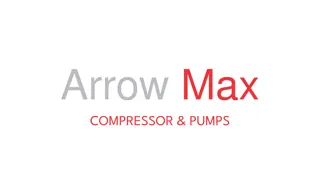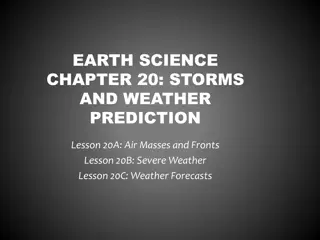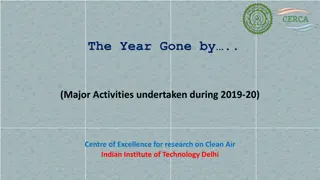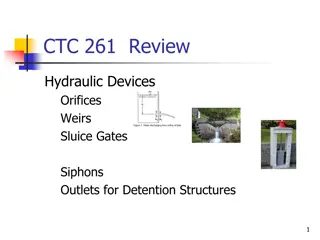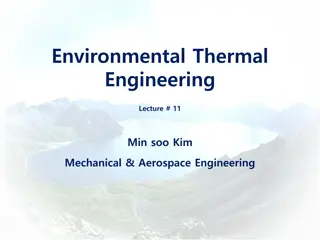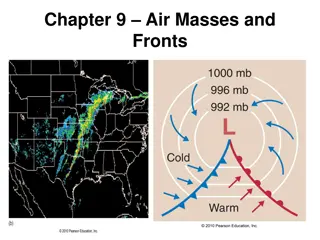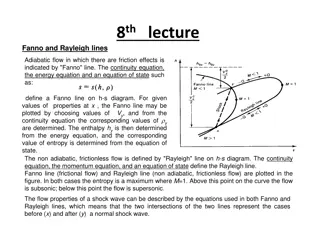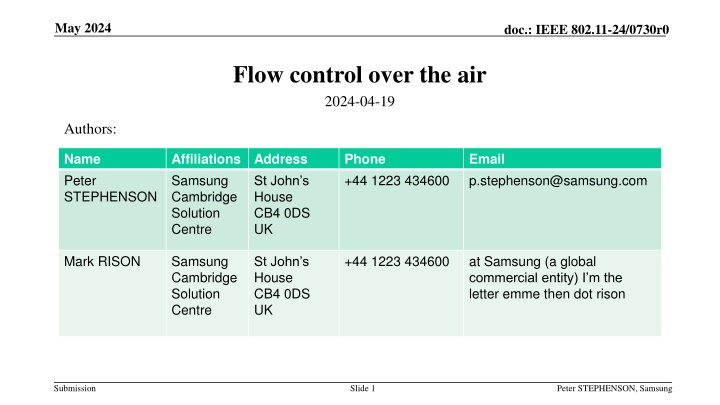
Enhancing IEEE 802.11 Standard with Flow Control Over the Air
Explore the need for flow control in wireless communications, a missing feature in IEEE 802.11 standard impacting data reliability. The discussion covers issues like Nak responses, retransmissions, and the MAC level problem, offering solutions for improved performance and reliability.
Download Presentation

Please find below an Image/Link to download the presentation.
The content on the website is provided AS IS for your information and personal use only. It may not be sold, licensed, or shared on other websites without obtaining consent from the author. If you encounter any issues during the download, it is possible that the publisher has removed the file from their server.
You are allowed to download the files provided on this website for personal or commercial use, subject to the condition that they are used lawfully. All files are the property of their respective owners.
The content on the website is provided AS IS for your information and personal use only. It may not be sold, licensed, or shared on other websites without obtaining consent from the author.
E N D
Presentation Transcript
May 2024 doc.: IEEE 802.11-24/0730r0 Flow control over the air 2024-04-19 Authors: Name Peter STEPHENSON Affiliations Samsung Cambridge Solution Centre Address St John s House CB4 0DS UK Phone +44 1223 434600 Email p.stephenson@samsung.com Mark RISON Samsung Cambridge Solution Centre +44 1223 434600 at Samsung (a global commercial entity) I m the letter emme then dot rison St John s House CB4 0DS UK Submission Slide 1 Peter STEPHENSON, Samsung
May 2024 doc.: IEEE 802.11-24/0730r0 Abstract Flow control or some equivalent back pressure on data flow is common in communications standards both wired and wireless but is missing from the IEEE 802.11 standard. Without it data is liable to drop into the void. A focus on reliability is a good time to plug this source of unreliability. The basic issue can be solved easily with a single bit in the BlockAck frame. Submission Slide 2 Peter STEPHENSON, Samsung
May 2024 doc.: IEEE 802.11-24/0730r0 Problem If a recipient cannot immediately process data received over the air, it can only Nak (not ack) it Typically this means a buffer is full The originator does not know the reason for the Nak The originator may simply retransmit the data as soon as it can There is no guarantee the retransmission can be processed on reception This is worst without a BlockAck frame (identical to missing Ack) Even with a BlockAck frame there is confusion with data lost due to bad radio conditions Submission Slide 3 Peter STEPHENSON, Samsung
May 2024 doc.: IEEE 802.11-24/0730r0 Not a configuration issue The problem exists at the MAC level (well below MLME) over a short period It is not fixed by renegotiating buffer sizes, changing operating mode, etc. These are passed up the stack for dealing with as a long-term change of mode It is an issue somewhere at around the level at which retransmissions are handled Or even lower, in EDCA / TB response scheduler Submission Slide 4 Peter STEPHENSON, Samsung
May 2024 doc.: IEEE 802.11-24/0730r0 Not a power save issue Asserting power save is not a fix Power save is asymmetric, only for data from AP to non-AP STA Power save signalling is passed up the stack Has implications for long-term buffering of data, use of TIM, etc. APs commonly continue delivering data after seeing PS bit set until buffer is drained Long-standing behaviour Reflects the fact that power save is about state change, not short-term signalling Submission Slide 5 Peter STEPHENSON, Samsung
May 2024 doc.: IEEE 802.11-24/0730r0 Endemic in the real world A mobile device will usually be resource-constrained in some ways There is a long way between the air interface and the application A mass-market phone that can always handle data sent to it might be considered over-specified! Assumption all data received will be processed goes back to early days In other words, low Mbps data rates 802.11 has expanded in many ways, not just in data rates The assumption means inefficient use of the wireless medium Time to retire it! Submission Slide 6 Peter STEPHENSON, Samsung
May 2024 doc.: IEEE 802.11-24/0730r0 MAC flow control in other standards MAC: at the level data is put into frames to go over the air Picking a couple of other short range digital wireless standards: Bluetooth Has had flow control from the beginning despite low data rates Actually two forms, MAC (LC) and at data transfer level (L2CAP) ECMA-368 UWB Not widely deployed, but interesting as MAC appears to be derived from IEEE 802.11n Flow control effectively implemented by fields in BlockAck frame (frame count and buffer size) More complicated than proposal here but basic effect is similar Submission Slide 7 Peter STEPHENSON, Samsung
May 2024 doc.: IEEE 802.11-24/0730r0 Solution: field in BlockAck frame All fast data in 802.11 uses A-MPDU with implicit BlockAckReq So insert a single bit in a reserved field in the BlockAck frame header There is space here, per-TID fields are full Meaning of bit: If 0: sender of BlockAck (BA recipient) can process more data on this TID / these TIDs (M-BA) If 1: sender of BlockAck (BA recipient) cannot immediately process more data on the TID(s) This bit is informational: it does not require the originator to take account of it The current behaviour is so ingrained that it doesn t seem sensible to mandate a different one Provides information that a high-quality originator implementation can make use of Submission Slide 8 Peter STEPHENSON, Samsung
May 2024 doc.: IEEE 802.11-24/0730r0 Resumption of data flow As use of flow control is not mandatory, originator can resume transmission immediately Or originator could wait an interval (perhaps learned from previous exchanges) Originator can also send a BlockAckReq at any time Recipient may change the flow control bit in the BlockAck response it sends Additional proposal: originator may send a gratuitous BlockAck So can send an update when the flow control state changes Well-defined: same as response to explicit BlockAckReq Recipient may simply ignore if not useful as only flow control bit may change To fix edge cases (e.g. no more data to send), originator can send (QoS) Null frame Submission Slide 9 Peter STEPHENSON, Samsung
May 2024 doc.: IEEE 802.11-24/0730r0 TIDs The flow control bit applies to any TID referred to in the BlockAck that contains it Useful if recipient has different buffers for e.g. voice and bulk data Could extend by using a reserved TID to signal general flow control for all TIDs Could extend further by allowing BlockAck with all-TID signal and zero bitmap to apply to non-BA TIDs So IoT device with low bandwidth that isn t using Block Ack can assert flow control Particularly useful without Block Ack as the only alternative is implicit Nak, same as lost frame Submission Slide 10 Peter STEPHENSON, Samsung
May 2024 doc.: IEEE 802.11-24/0730r0 Other bells and whistles Could add bit to say some MPDUs in A-MPDU just received weren t processed Then originator knows MPDUs not acked shouldn t be ascribed to bad radio conditions Could indicate a delay after which recipient expects to be able to receive again Equivalent to sending BlockAck with flow control on at this time Submission Slide 11 Peter STEPHENSON, Samsung
May 2024 doc.: IEEE 802.11-24/0730r0 Summary Lack of flow control is a long-term gap in IEEE 802.11 standard Probably didn t seem important when rates and reliability were low This seems a good opportunity to plug the gap Use of existing Block Ack scheme makes it cheap to add Controlled flow is more reliable flow Submission Slide 12 Peter STEPHENSON, Samsung
May 2024 doc.: IEEE 802.11-24/0730r0 Straw poll Flow control should be developed as a mechanism for increasing reliability of data over the air Y N A Submission Slide 13 Peter STEPHENSON, Samsung
May 2024 doc.: IEEE 802.11-24/0730r0 References ECMA-368 UWB MAC, https://ecma-international.org/wp- content/uploads/ECMA-368_3rd_edition_december_2008.pdf (see section 17.8.3.2) Submission Slide 14 Peter STEPHENSON, Samsung


